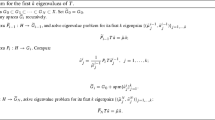Abstract
Schwarz methods are an important type of domain decomposition methods. Using the Fourier transform, we derive error propagation matrices and their spectral radii of the classical Schwarz alternating method and the additive Schwarz method for the biharmonic equation in this paper. We prove the convergence of the Schwarz methods from a new point of view, and provide detailed information about the convergence speeds and their dependence on the overlapping size of subdomains. The obtained results are independent of any unknown constant and discretization method, showing that the Schwarz alternating method converges twice as quickly as the additive Schwarz method.
Similar content being viewed by others
References
Schwarz, H. A. Gesammelte Mathematische Abhandlungen, Vol. 2, Springer, Berlin, 133–143 (1890)
Lions, P. L. On the Schwarz alternating method I. Proceedings of the 1st International Symposium on Domain Decomposition Methods for Partial Differential Equations (eds. Golub, G. H., Meurant, G. A., Periaux, J., and Glowinski, R.), SIAM, Philadelphia, 1–42 (1988)
Lü, Tao, Shih, T. M., and Liem, Z. B. Domain Decomposition Methods-New Numerical Techniques for Solving PDE (in Chinese), Science Press, Beijing (1992)
Bjørstad, P. E. Multiplicative and additive Schwarz methods: convergence in the two subdomain case. Proceedings of the 2nd International Symposium on Domain Decomposition Methods (eds. Chan, T. F., Glowinski, R., Periaux, J., and Widlund, O.), SIAM, Philadelphia, 147–159 (1989)
Zhang, Xuejun. Two-level Schwarz method for biharmonic problems discretized by C 1 conforming elements. SIAM J. Numer. Anal. 33(2),555–570 (1996)
Xu, Xuejun, Lui, S. H., and Rahman, T. A two-level additive Schwarz method for the Morley nonconforming element approximation of a nonlinear biharmonic equation. IMA J. Numer. Anal. 24(1),97–122 (2004)
Shi, Zhongci and Xu, Xuejun. The mortar element method for a nonlinear biharmonic equation. J. Comput. Math. 23(5),537–560 (2005)
Gander, M. J. Optimized Schwarz methods. SIAM J. Numer. Anal. 44(2),699–731(2006)
Chen, Shuxing. Introduction to Modern Partial Differential Equations (in Chinese),Science Press, Beijing (2005)
Dolean, V., Nataf, F., and Rapin, G. Deriving a new domain decomposition method for the Stokes equations using the Smith factorization. Math. Comp. 78(266),789–814 (2009)
Li, Kaitai, Ma, Yichen, and Wang, Lizhou. Distributions and Sobolev Spaces (in Chinese),Xi’an Jiaotong University Press, Xi’an (2008)
Author information
Authors and Affiliations
Corresponding author
Additional information
Communicated by Zhe-wei ZHOU
Project supported by the National Natural Science Foundation of China (No. 10671154), the National Basic Research Program (No. 2005CB321703), and the Science and Technology Foundation of Guizhou Province of China (No. [2008]2123)
Rights and permissions
About this article
Cite this article
Shang, Yq., He, Yn. Fourier analysis of Schwarz domain decomposition methods for the biharmonic equation. Appl. Math. Mech.-Engl. Ed. 30, 1177–1182 (2009). https://doi.org/10.1007/s10483-009-0912-6
Received:
Revised:
Published:
Issue Date:
DOI: https://doi.org/10.1007/s10483-009-0912-6



